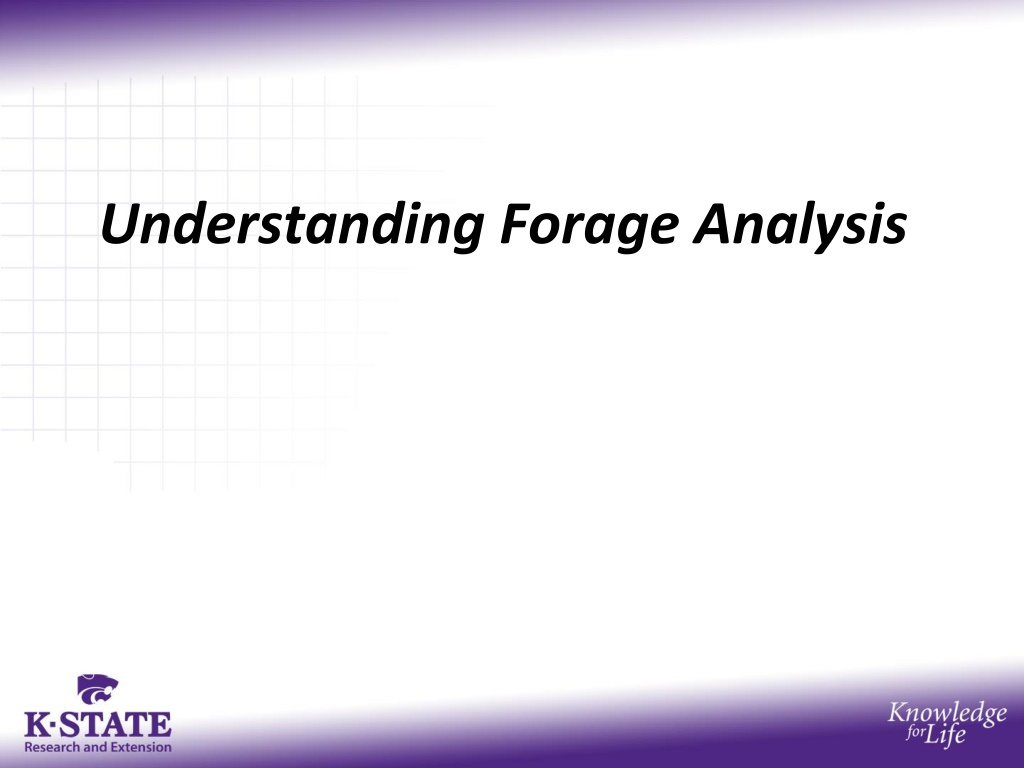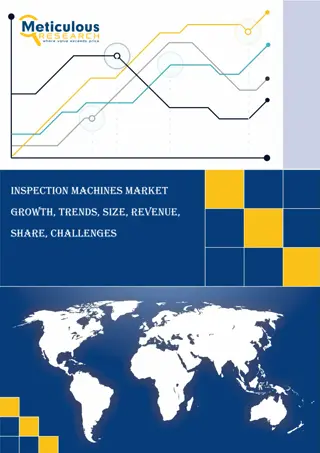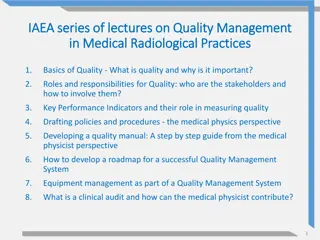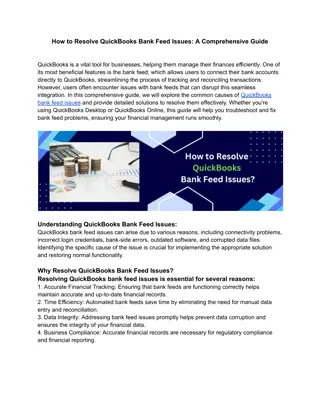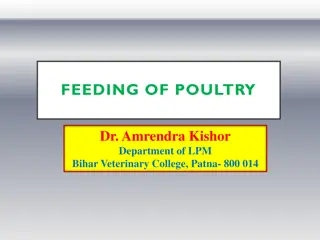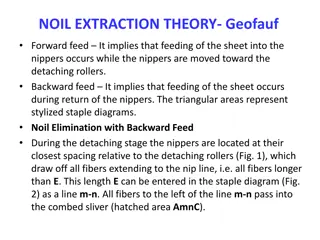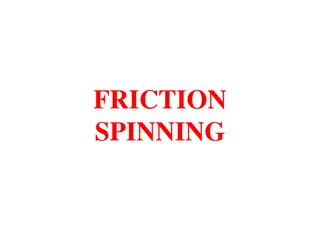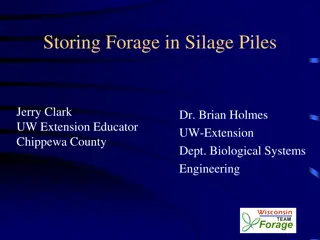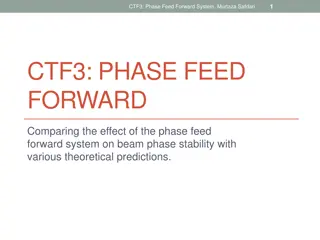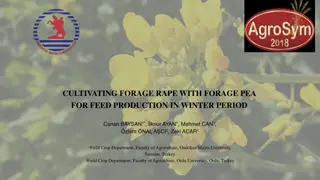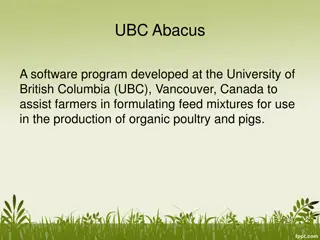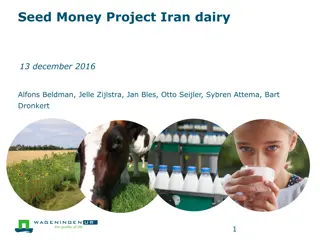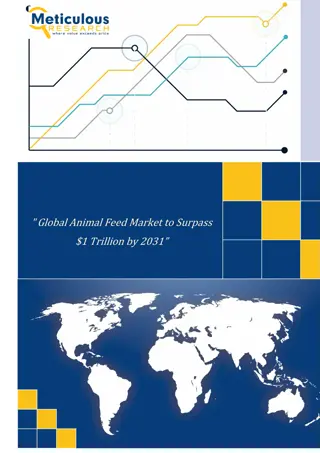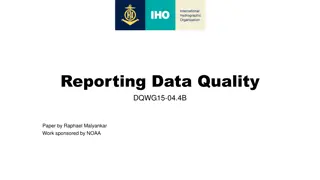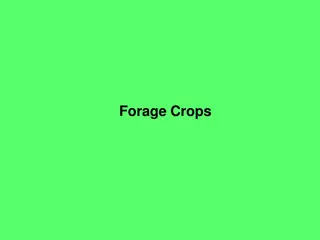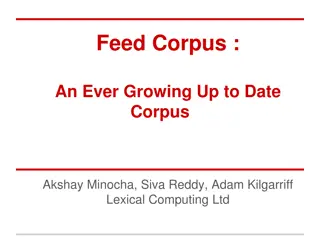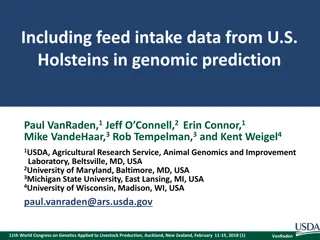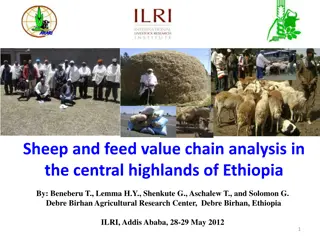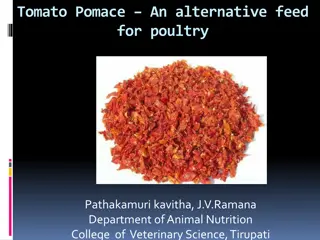Understanding Forage Analysis Methods for Evaluating Feed Quality
Evaluating forage quality is crucial for predicting animal performance. Methods include qualitative and quantitative analysis, along with assessing basic nutrient components like moisture, crude protein, and fiber content. Laboratory analysis provides valuable data for optimizing animal nutrition and feed efficiency.
Download Presentation

Please find below an Image/Link to download the presentation.
The content on the website is provided AS IS for your information and personal use only. It may not be sold, licensed, or shared on other websites without obtaining consent from the author. Download presentation by click this link. If you encounter any issues during the download, it is possible that the publisher has removed the file from their server.
E N D
Presentation Transcript
Evaluating Forage Quality The best method of evaluating a feed/forage is animal performance Feed and record performance Intake (palatability), digestibility, efficiency Time consuming, expensive Laboratory analysis is an economical means of gathering data which may be used to reliably predict animal performance
Evaluating Forage Quality Qualitative Color, leafiness, smell, texture, Dust, mold, foreign material (wire, cans etc.) Quantitative Analysis conducted in the laboratory Chemical composition Direct Indirect (NIR Near infrared reflectance spectroscopy)
Basic Components of Nutrient Analysis Moisture Dry Matter As Received Total Nitrogen Crude Protein Acid Detergent Fiber (ADF) Total Digestible Nutrients Metabolizable Energy Net Energy Maintenance Net Energy Production Neutral Detergent Fiber (NDF) Relative Feed Value Mineral Analysis
Moisture or Dry Matter Simple, but important analysis Removing water allows us to compare straw to silage Removing the water within the sample Dry forages (hay) Forced air oven at 100-105 C for 24 hours Wet forages (fresh clipped, silage) 2 stage drying process Forced air oven at 55 C followed by 105 C
Crude Protein Nitrogen content is measured Kjeldahl analysis (Johan Kjeldahl, 1880 s) Uses strong acids to digest sample Total combustion is commonly used today Sample is burned and nitrogen is captured and measured Nitrogen * 6.25 = crude protein content Most proteins contain ~ 16% Nitrogen Conversion factor of 6.25 (100/16 =6.25)
Detergent Fiber Analysis (NDF and ADF) Developed by P.J. Van Soest (1960 s) to partition plant samples into 2 fractions 1. Plant cell contents (highly digestible) 2. Plant cell wall (vary in digestibility) Developed to replaced crude fiber (1860 s) Crude fiber tends to underestimate cell wall content Still used today on feed tags as legal standard
Plant Cell Wall Components and the Detergent Fiber System Cellulose Hemicellulose Lignin http://www.scidacreview.org Neutral Detergent Fiber (NDF) Cell contents are removed Measures amount of hemicellulos, cellulose, and lignin Correlated with animal intake Acid Detergent Fiber (ADF) Removes Hemicellulose Measures amount of cellulose and lignin Correlated with digestibility Van Soest, 1984
Energy Estimates Total Digestible Nutrient (TDN) Net Energy Net energy maintenance (NEm or NE maint.) Net energy production Gain, Lactation (NEg, NEl) These are calculated from ADF due to its correlation with digestibility of the forage
Total Digestible Nutrients Oldest estimate of energy availability (1860 s) Widely accepted most recognized Sum of the digestible protein, carbohydrates and fat (multiplied by 2.25) Only accounts for fecal losses, so tends to overestimate value of forages
Net Energy System Takes into the energy associated with feces, urine, gas, and heat produced and the purpose for which the feed is used (maintenance and production) Gain Lactation Production Maintenance Feed Intake Lofgreen and Garrett, 1968
Energy Estimate Equations National forage testing assoc. http://www.foragetesting.org
Relative Feed Value (RFV) Essentially ranks forages by potential digestible dry matter intake relative to full bloom alfalfa (RFV = 100) Digestible dry matter (DDM) = 88.9- (0.779 x ADF%) Dry matter intake (DMI) = 120/ %NDF Relative Forage Value = DDM x DMI/1.29 RFV has no specific meaning it is purely a means of ranking forages National forage testing assoc. http://www.foragetesting.org
Relative effect of alfalfa maturity on CP, ADF, NDF, TDN, and RFV Stage of Maturity CP% ADF% NDF% *TDN% RFV Bud 25 28 38 67.1 164 Early Bloom 23 30 40 65.5 125 Mid Bloom 19 35 46 61.6 125 Full Bloom 16 41 53 57.0 100 * Calculated TDN% = 88.9 (0.779 * ADF%) Adapted from: http://facts.okstate.edu/docushare/dsweb/Get/Document-2557/PSS-2117web.pdf
Relative Forage Quality (RFQ) Developed as an improvement over RFV, as it uses TDN rather than digestible dry matter Maybe used on both legumes and grasses RFQ also has no specific meaning, as it as index that may be used to compare forages. Jeranyama and Garcia, 2004 SDSU bulletin 8149
NIRS Analysis Near Infrared Reflectance Spectroscopy First used to predict forage quality in 1976 Rapid and requires minimal sample preparation relative to traditional chemistry Less expensive than traditional methods
NIRS: Basic Principle Hay Sample Infrared light Reflected Light Detector Cell Relationship between the amount of reflected light and analyte (i.e. CP) is used to determine concentration of analyte in sample Y=mx +b
NIRS: General Comments NIRS is an excellent analytical tool when used properly Instrument is calibrated using wet chemistry values Good method works well with common forages Lower cost, so more samples may be submitted
Other Terms Amylase Neutral Detergent Fiber (a NDF) The enzyme amylase is added to the NDF solution to help breakdown starch Acid Detergent Insoluble Nitrogen (ADIN) Nitrogen bound within the ADF fraction Indication of heat damage in feeds In-vitro Dry Matter Digestibility (IVDMD) Sample undergoes simulated ruminal digestion Correlated with TDN
The Value of Forage Testing 1400 lb, 3rd trimester cow Consumes 2% bodyweight = 28 lbs 7% CP forage * 28 lbs 6% CP forage * 28 lbs = 1.96 lbs CP/d = 1.68 lbs CP/d 0.28 lbs CP/d 1.4 lbs of 20% supplement/d (0.28/0.20) 1.4 lbs * 60 days = 84 lbs supplement 84 lbs ($400/ton) = $16.80/cow
